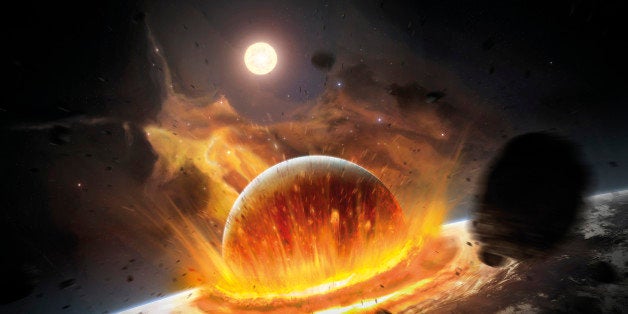
The United States, Russia, and China are now aggressively pursuing a new generation of smaller, less destructive nuclear weapons. The buildups threaten to revive a Cold War-era arms race and unsettle the balance of destructive force among nations that has kept the nuclear peace for more than a half-century.
Thus warned William J. Broad and David Sanger in
Race for Latest Class of Nuclear Arms Threatens to Revive Cold War,
New York Times, April 17, 2016. They had first sounded the alarm in
As U.S. Modernizes Nuclear Weapons, 'Smaller' Leaves Some Uneasy,
New York Times, January 12, 2016.
A New Generation of Nuclear Arms, Really?
A new generation of nuclear arms simply does not make sense based on the experience of the past 55 years:
1. Nuclear deterrence, based on a balance of terror (and mutual assured destruction) between the United States and the USSR during the Cold War, worked. And it continues to work today. A new buildup in the name of "miniaturization" threatens to revive an unnecessary and prohibitively expensive arms race.
2. Once a kind of strategic parity was achieved, it was the strategic arms talks per se, not a renewed arms race, between the two superpowers that provided a modicum of geopolitical stability -- more than the actual SALT (Strategic Arms Limitation Talks) and START (Strategic Arms Reduction Talks) limits on and reductions in nuclear-armed ICBMs, SLBMs, and bombers.
The new START treaty of 2010 -- to last for ten years -- allows for 700 deployed intercontinental missiles and bombers; and 1,550 deployed nuclear warheads each, under the control of Washington and Moscow.
3. A trillion-dollar program to build a new generation of smaller nuclear warheads will invite proliferation, and encourage political de-stabilization in relations between the great powers. WHY does the U.S. need discriminate nuclear options at all rungs of the nuclear escalation ladder as part of the modernization process? To what end, unless we are contemplating scenarios for fighting limited nuclear war?
SecDef Perry and Gen. Cartwright
Former Secretary of Defense William Perry, a sage on these matters, has summed up the danger: the smaller-yield nuclear arms could make the unthinkable more likely:
They make the weapons seem more usable even if there's no credible plan for how you control escalation.
Gen. James E. Cartwright, retired vice chairman of the Joint Chiefs of Staff and a former SAC commander--who backs "the upgrades" because precise targeting would allow the United States to hold fewer weapons--admits that
what going smaller does is to make the weapon more thinkable
; or
makes the trigger easier to pull but makes the need to pull the trigger less likely.
(sic)
On the contrary, the smaller yields and better targeting could make the arms more tempting to use -- even to use first, rather than in retaliation.
Nuclear Labs
The Energy Department -- whose eight factories and laboratories stay in business by dreaming up these next steps -- is responsible for upgrading the warheads to fit onto some new Air Force delivery system. It argues that this is the fastest way to reduce the nuclear stockpile, promoting the effort as modernize to downsize. Example: The B61 Model 12, a dial-a-yield bomb flight-tested last year in Nevada, that could be fitted onto a hypersonic glide vehicle.
President Obama
President Obama recently demonstrated at the Nuclear Security Summit an awareness of
the potential for ramping up new and more deadly and more effective systems that end up leading to a whole new escalation of the arms race.
It remains for his Secretary of Defense, Ash Carter, to squash loose Pentagon speculation about such deadly-serious matters.
This country does not need a new nuclear arms race. We have more than enough, in numbers and variations, to maintain intercontinental strategic deterrence. Of course, communication links between nuclear triad weapons and their guardians need better protection against cyberattack.
Incidentally, I am opposed to getting rid of all nuclear weapons in the stockpile; but favor yet lower levels of missiles, bombers, and warheads. Under the guise of a deterrence policy ostensibly intended to reduce the centrality of nuclear arms, we must not contribute to a second nuclear age.
Conclusion
At the height of the Cold War, I was a junior official in the International Division of the Bureau of the Budget, Executive Office of the President, next door to the White House. On June 10, 1963, President John Kennedy gave a magnificent speech at American University that launched the successful quest for the first nuclear test ban treaty. It bequeathed to me what became a high calling in my professional life, the avoidance of a nuclear war between the United States and Russia:
War makes no sense in an age when a single nuclear weapon contains almost ten times the explosive force delivered by all of the allied air forces in the Second World War. It makes no sense in an age when the deadly poisons produced by a nuclear exchange would be carried by the wind and water and soil and seed to the far corners of the globe and to generations unborn.
I later served as Executive Director of the U.S. General Advisory Committee on Arms Control, 1978-80; a presidential board that included two NSC advisers -- Gen. Brent Scowcroft and MacGeorge Bundy, Los Alamos director Harold Agnew, and Thomas J. Watson Jr. of IBM as chairman. Over time, I inspected all three legs of the nuclear-armed TRIAD; and visited Russia during the administrations of Jimmy Carter, Ronald Reagan, and George H.W. Bush.
(With revisions...)